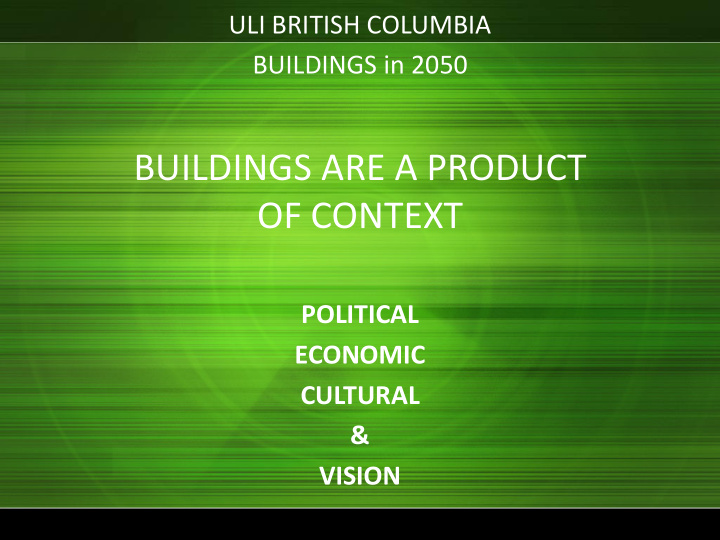



ULI BRITISH COLUMBIA BUILDINGS in 2050 BUILDINGS ARE A PRODUCT OF CONTEXT POLITICAL ECONOMIC CULTURAL & VISION
WORLD POPULATION in 2050 9.5 BILLION c omprised of: 5.9 BILLION (62%) Africa, S & E Asia includes 3.0 BILLION India and China 440 MILLION USA 674 MILLION Europe 43 MILLION Canada (87% Urban) 623 MILLION North America 140 MILLION Mexico Map produced by the SASI group (Sheffield) and Mark Newman (Michigan)
CANADA in 2050 43M population on the 2cd largest land mass in the world Significantly under populated for optimum economy, Dependant on USA for national boundaries protection Canada has the world’s largest water supply, Abundant food supply, and Abundant natural resources Vancouver will be a major North American gateway to 33% of the world’s population located in China and India, countries with very significant immigrant populations within Canada/BC
CANADA in 2050 Beyond normal immigration, what will be Canada’s share of the estimated 100M Climate Migrants in 2050 – fleeing the “too hot, crowded and too wet” portions of the world. An opportunistic immigration policy of 400,000/yr vs the projected 250,000/yr of new immigrants/natural growth could increase Canada’s population to 50M by 2050.
CANADA in 2050 By 2050 - 87% of Canada’s population will be in urban 87% of Canada’s population will be in urban centers Immigration patterns to 2006 generated 90% located around 33 metropolitan areas 50% - located in/around Montreal, Toronto, Vancouver Economic opportunity attracts population growth Accessibility drives population distribution Affordability drives population settlement
VANCOUVER in 2050 • Metro Vancouver population could grow to 4,000,000 from Metro Vancouver population could grow to 4,000,000 from current population 2.2 million More aggressive growth rates could yield 5,000,000 What are the attitudes, issues and requirements related to accommodating 1,800,000 to 2,800,000 new residents in the Metro Vancouver over the next 40 years? Will we embrace significant immigration growth and become a stronger more self sustaining part of the global economy “The future isn’t a place we go to, it is a place we create”.
VANCOUVER in 2050 Attract intellectual /economic capital to our region to transform from a tourist destination /retirement “resort” for the wealthy to a world class, urban city with a robust economy and a vibrant future, by: Coordinated cross regional planning policies guided by a common vision of the Region Planned distributed of populations centered on rapid transit for optimal density/utilization Effective incentives / measures to ensure residential affordability and liveability and commensurate public amenity
VANCOUVER in 2010 Population and Density (persons per sq km) in 2006 Population and Density (persons per sq km) in 2006 Metro Vancouver 2.2M in 2,878 km² (735 persons/km²) City of Vancouver 580,000 in 115 km² (5,040 persons/km²) * Burnaby, Surrey, Richmond, Coquitlam, Port Coquitlam, New Westminster, Port Moody, and Vancouver,
VANCOUVER in 2050 Population Density (persons per sq km) in 2006 Population Density (persons per sq km) in 2006 Currently 8*cities contain 1,716,00 people on 704 km² (24.5% of Metro Vancouver land area of 2,878 km²) If these 8 cities and 704 km² were populated at the Vancouver density rate of 5,040 persons/km² population could be 3,546,700 persons * Burnaby, Surrey, Richmond, Coquitlam, Port Coquitlam, New Westminster, Port Moody, and Vancouver,
VANCOUVER in 2050 Increasing Density on 3 Rapid Transit lines at 2.5X Increasing Density on 3 Rapid Transit lines at 2.5X Vancouver density (12,700 p/sq/km) generates 1,270,000 people Develop the balance of lands at the current Vancouver density of 5,040 p/sq/km generates 3,040,000 people: total population of 4,310,000 (6,750 p/sq/km) Translink Stations shown on current Expo, Millennium, Canada Lines (and proposed Evergreen Line)
BUILDINGS in 2050 There will be a shift from conceiving of buildings as being in the landscape to one of experiencing the urban environment/buildings as the urban landscape We will have considered the relationship between building heights and density in relationship to panoramic “views of the mountains” from within the City In the interests of creating a vibrant pedestrian oriented urban realm in the downtown core area(s) for public squares, mid block pedestrian ways and distributed cultural facilities throughout the distributed urban cores.
BUILDINGS in 2050 Sustainable Cities in 2050 will be shaped by: Sustainable Cities in 2050 will be shaped by: Transit oriented high density High performance resource sensitive buildings Mixed use buildings with built in adaptability over economic life Dynamic, engaging multi layered ground planes and public spaces
FUTURE VISIONS
FUTURE VISIONS Ken Yeang – Green Towers, MAD Architects – Urban Forest, OR Design - Sustainability Centre
VANCOUVERISM Seawall at False Creek North (day) and Coal Harbour (night)
HIGH DENSITY BUILDINGS Fairmont Pacific Rim, Vancouver, 2010
HIGH DENSITY ALTERNATIVES Vanke Centre, Shenzen , 2010
HIGH DENSITY ALTERNATIVES Vanke Centre, Shenzen , 2010
HIGH DENSITY ALTERNATIVES 60 Richmond Housing Co-Op, Toronto, 2009
HIGH DENSITY ALTERNATIVES 60 Richmond Housing Co-Op, Toronto, 2009
MEDIUM DENSITY ALTERNATIVES Borneo Sporenburg Housing, Amsterdam, 1996-2000
VERTICAL COMMUNITIES Millennium Tower , Tokyo. 1988
PROGRESSIVE OFFICES FA Swiss Tower “The Gherkin”, London, 2006
PROGRESSIVE OFFICES Commerzbank Tower, Frankfurt, 1997
PROGRESSIVE OFFICES Manitoba Hydro Place, Winnipeg, 2010
URBAN LANDSCAPES Parkade, Shanghai, 2006 - Athlete's Village, Vancouver, 2010
NET NET- NET ZERO BUILDINGS Masdar Headquarters, Abu Dhabi, Completion 2013
NET ZERO CITIES Masdar City, Abu Dhabi, Completion 2012
CULTURAL FACILITIES Copenhagen Opera House, Copenhagen, 2007 – Oslo Opera House, Oslo, 2006
PARKS AND PLAZAS Millennium Park, Chicago, 2001 – Olympic Park, Seattle, 2004
Recommend
More recommend